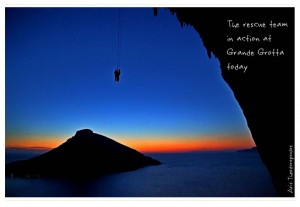
Earlier today, the relatively new Kalymnos Rescue Service was summoned to Grande Grotta by a couple of climbers in need-and it rose to the task. When the UK couple tried to rappel down the wrong abseil point after climbing the multi-pitch route Massalia they found themselves stranded in mid-air with nowhere to go. They had used the wrong abseil point: the one for Massalia is over sector Panorama, and descending from it involves two 31-meter rappels; instead, the climbers started to abseil down the point of another route, Three Stripes, which is located about 50m to the right of where Massalia ends. The impressive rappel of Three Stripes requires two 80m ropes and takes you down the center of Grande Grotta’s magnificent void. With only one 80m rope, and with one of the climbers having limited experience climbing outdoors, the couple started to rappel together. When they realized their rope was too short it was too late to do anything, and the Kalymnos Rescue Service was called.
It was the team’s first call for a rescue this year. On the scene arrived Claude Idoux, Vaios Karalaios and Alexandros Istatkof, and they helped the two climbers down with static ropes. On the ground were also Aris Theodoropoulos to support as needed and two climbers who volunteered to climb Massalia to bring up one of the ropes used. All ended well and the rescue was free of charge for the climbers involved.
Which brings the issue of the rescue team’s viability to the forefront. Most climbers would likely agree that a rescue service is fundamentally vital for such a popular climbing venue. Sadly, expecting the municipality to fund it is nothing short of a fantasy. For the time being the rescue service is funded by a private party (see below); but these funds will eventually run out and the service will cease to exist. It’s simple math. We climbers ought to support it as best we can. If you haven’t read our older post about the Kalymnos Rescue Service, please do so below and share your thoughts on how to make this vital service viable.
(As an aside, please remember: indoor and outdoor climbing are vastly different and there are perils unique to outdoor climbing. You must do your homework before climbing outdoors, even at a “user-friendly” climbing venue such as Kalymnos.)
A new rescue team on Kalymnos
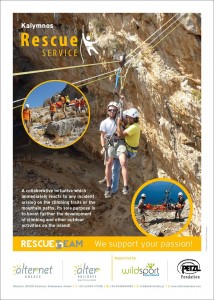
(The original post appeared on our website on October 17th 2013. Please read the updated version below.)
Kalymnos is widely considered one of the safest climbing venues in the world, largely thanks to the excellent rock quality, dense bolting with stainless-steel bolts, and overall good organization of the crags. However, as it is also one of the most popular climbing destinations worldwide with thousands of climbers visiting every year, chances of human error and accidents increase accordingly. Until now there was no rescue team on Kalymnos. When an accident happened, the injured climber relied on a handful of dedicated local volunteers and the stretcher and donation fund from the Glaros Bar. Now there is a new rescue team on Kalymnos funded and organized by a local company and staffed by climbers / volunteers; a very important, and hopefully viable, initiative. Here are the details.
The rescue team
There are six volunteer climbers staffing the main rescue team. They are trained to rescue an injured person from the crags and approach paths with or without the use of ropes and to provide first aid. Another 14 volunteers are trained to help. A local company, Alternet, organized and funded the creation of the rescue team; specialized equipment was donated by Wild Sport in Masouri, and the Petzl Foundation supported the initiative by offering additional 5-day training to the six main volunteers of the rescue team.
How can climbers help support the Kalymnos Rescue Team?
Rescue services are temporarily provided free of charge. In the near future there may be a fee charged for each rescue performed; we will update here when we know more. In the meantime, there are two ways to support this very important service.
Donations
Donations are accepted, and greatly appreciated, by the Kalymnos Rescue Team. To make a donation you can email the Rescue Team, visit their website, or stop by the Rescue Office on the ground level of Oasis Hotel in Masouri.
Alternet Rescue Card
The agency which formed the Rescue Team also provides the Alternet Rescue Card. The cost of the Rescue Card starts at 15 EUR for 15 days, and cardholders benefit from an array of discounts at restaurants, hotels, and the Kos-Kalymnos ferry, among others. A percentage of the proceeds from sales of the Rescue Card goes to the Rescue Team. You can buy the card at Alternet’s office on the ground floor of Oasis Hotel.
An Android app will also be available soon for smartphones and tablets. This app will be free of charge for the Rescue Package cardholders, and it includes an SOS risk button. Here’s how it will work: In case of emergency, the owner of the application (climber or hiker) activates the GPS tracking system with a simple push of the button. A location signal is automatically transmitted via text message to the base (Alternet office) and to the interconnected mobile phones of the Rescue Team. The location is pinpointed on the digital map based on the coordinates of the SOS emission.
For more info, here is Alternet’s full rescue brochure and here is their Rescue Service page.



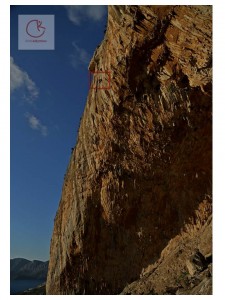
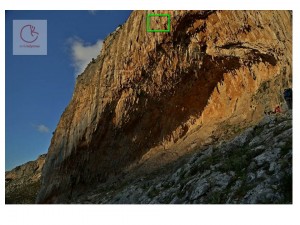
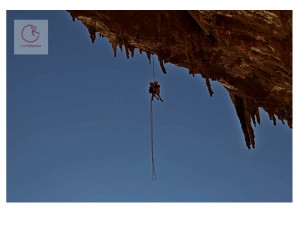
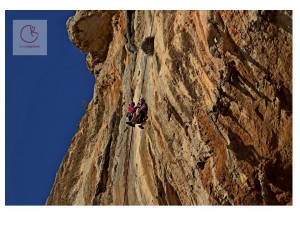

1 Comment
Great effort. Good to read that – if something happens – we are safe!
Maybe the right (or easiest) way to help maintaining Kalymnos as the climbing paradise is (something they invented decades ago) increasing the touristic tax. This is even better and easier then introducing a climbing permit (I think).